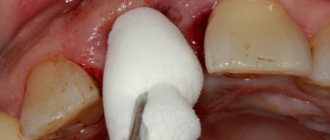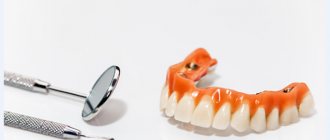Suturing the gums after tooth extraction: when required
On the eve of a surgical operation, patients are often interested in whether it is necessary to apply sutures after removing a tooth - wisdom, canine, incisor. There are certain indications for gum suturing:
- Dental implantation. When choosing a one-stage tooth restoration protocol, the patient must undergo two surgical interventions at once. This is tooth extraction and immediate implantation. In order for the dental implant to take root in the bone tissue without any problems, the doctor will apply sutures and leave the implant in the tooth socket.
- Removing eights. Wisdom teeth are characterized by enlarged roots, an uncomfortable position in the jaw row, and difficulty in extraction. When third molars are removed, soft and bone tissues are severely damaged, heavy bleeding begins, and severe pain is possible. To reduce unpleasant consequences, the doctor places a hemostatic sponge in the hole and sutures the gums after tooth extraction.
Sutures are also indicated when there is a threat of severe bleeding, extraction of dystopic and impacted teeth. The manipulation is also performed at the patient’s personal request.
Prevention of seam dehiscence
The postoperative wound is sutured with strong elastic threads. They do not diverge spontaneously. But if the patient violates the doctor’s recommendations, such a complication is possible. To prevent sutures from coming apart after implantation, you need to:
- do not eat for three hours after implant placement;
- for the first two days, apply cold compresses according to the regimen prescribed by the dentist;
- use rinses or baths prescribed by your doctor;
- do not chew on the side of the operation;
- refrain from spicy, hot, hard, sticky foods until the stitches are removed;
- give up physical activity.
Why did you sew up the hole after tooth extraction?
If stitches were applied after wisdom tooth removal, this will only be beneficial. Repeated studies have proven that a sutured socket is:
- reducing the risk of infection and complications - by 90%;
- rapid stop of bleeding;
- preservation of the blood clot and natural healing of the wound;
- minimal pain after surgery;
- rapid fusion of tissues thanks to sutures.
Sutures are placed on the socket immediately after the removal operation. After which the doctor gives recommendations for accelerated healing and rapid normalization of the general condition.
Recommendations for further gum care
In a broad sense, dental implantation is not completed after the sutures are removed. The postoperative wound heals completely only after three to four weeks. The artificial root is overgrown with bone tissue within several months. And only after the completion of the regeneration and osseointegration processes can we say that the implant is securely installed and can be loaded with a prosthetic structure.
After removing the sutures from the wound, you should follow the dentist's recommendations. In particular, it is important:
- after eating, rinse your mouth with disinfectant solutions;
- brush your teeth with care, without touching the implantation area;
- Until the wound is completely healed, do not neglect regular oral hygiene.
Compliance with the doctor’s prescriptions and recommendations helps the patient go through the first part of the rehabilitation period without complications.
Types of seams and suture materials
The patient’s further actions depend on what materials and suturing technique the surgeon used in dentistry. There are seams:
- Intermittent - stitches are applied separately, each secured with its own knot. Damage to one stitch does not affect the integrity of the others, allowing you to keep the hole closed.
- Continuous - all stitches are made with one suture thread and have a common knot. If one stitch is damaged, the entire seam comes apart.
Features of suture material:
- Absorbable threads are a sterile material of natural or synthetic composition, which after some time disintegrates into independent elements. During the healing process of the hole, the sutures securely fix the wound and then completely dissolve.
- Non-absorbable compounds are common synthetic threads used by dental surgeons in their work. These are polyester, nylon, silk, monofilament.
The material and features of suturing influence how the sutures are removed after the removal of a wisdom tooth or another unit.
What affects the timing of suture removal?
Gum healing sometimes occurs with peculiarities. The rate of tissue regeneration is influenced by the following factors:
- patient's age;
- the presence of chronic diseases;
- bad habits that persist after implantation;
- volume of surgical intervention.
Healing time may be delayed if a person has diabetes or smokes. In this case, the stitches are most often removed after two weeks.
The date for removal of the suture material is determined by the dentist. It is important to come on the specified day, since performing this procedure late may lead to undesirable consequences.
We sewed up the gum after tooth extraction: when to remove the sutures
Removal of sutures from the gums after tooth extraction is carried out 7-10 days after surgery. The doctor invites you to a follow-up appointment. When examining the patient’s oral cavity, the dentist notes the quality of wound healing and the general condition of the tissues in the area of the extracted tooth.
If healing goes well, the stitches will be removed on the same day.
How long does it take for sutures to dissolve after tooth extraction?
We sewed up the gum after tooth extraction - when the stitches dissolve depends on the material. There are many factors that determine the rate of natural destruction:
- composition - synthetic and natural;
- method of production of threads - what affects the breakdown of the composition;
- individual characteristics of the patient’s body - in particular the state of the immune system;
- the composition of saliva - destruction occurs under its influence.
There are approximate guidelines for when sutures dissolve after wisdom tooth removal, depending on the composition:
- 20-30 days - synthetic self-absorbing sutures after tooth extraction;
- 10-100 days - absorbable materials based on enzymes.
In what cases are sutures placed on the gums?
When to remove sutures on the gums. Types of threads, how and why gums are sutured
The dentist fights to save a tooth like an inch of his native land in war. But there are cases when it is necessary to pull out a tooth: if it is practically destroyed, there is purulent inflammation in the root area.
When removing a wisdom tooth, sutures are required on the socket or gum papillae. This is due to the traumatic nature of the operation - damage to a large volume of tissue due to the deep roots of the “eight” and the possible growth of the tooth at an angle.
An additional tissue incision near the tooth is often necessary. Then, after extraction, the surgeon has to sew up the gum.
An incision is necessary when:
- removal of impacted teeth;
- severe destruction of the tooth crown;
- pathologies of its location - dystopia;
- curvature of roots.
Operations that require subsequent suturing of tissue are performed not only for problems with teeth, but also in the treatment of pathology of the gums (after removal of a cyst, abscess, fistula), jaw (fracture, osteomyelitis).
Sutures on the gums are required for patients with bleeding disorders to avoid prolonged, dangerous bleeding.
Why do gums need to be sutured after tooth extraction?
If the patient's gums are sutured, this will help it heal faster and without complications, because:
- the risk of infection of a wound closed with a suture is reduced by 90%;
- bleeding stops faster;
- a blood clot formed in the socket during surgery is an obstacle to the penetration of microorganisms deep into the wound;
- food particles do not enter the wound and do not injure the wound;
- sutures bring the edges of the tissues together, helping to grow together.
To heal the wound after suturing it is impossible on the 1st day:
- rinse your mouth so as not to wash out the clot that forms from the wound;
- warm the gums;
- chew on the side of the wound;
- eat too hot, hard food;
- smoke and drink alcohol;
- engage in heavy physical labor and sports.
This prevents wound infection, tissue injury, and bleeding.
How to remove suture threads from a tooth socket
Many people associate the removal of sutures with unpleasant pain. Pain occurs only in people with a low pain threshold, increased sensitivity, or when there is inflammation in the tooth socket. Usually the patient experiences only discomfort.
Stages of removing suture material:
- treating the patient's oral cavity with an antiseptic;
- examination of the mucous membranes for hyperthermia, swelling, suppuration;
- the use of topical anesthesia to prevent even minimal pain;
- cutting the threads with a special dental instrument - the stitches are divided in half, especially in the case of an intermittent suture line;
- removing pieces of thread with tweezers;
- checking the density of the scar and the quality of wound healing.
Next, the patient will be asked to rinse his mouth with an antiseptic composition.
The first three days after the stitches are removed, stiffness of movements and discomfort when opening the mouth are possible.
How does healing occur, what consequences of the operation are considered normal?
It is worth mentioning right away that the process of implant integration does not end with the regeneration of soft tissues - osteogenesis must occur, that is, fusion of the bone with the implant. It takes about six months for complete restoration of both bone and soft tissue, starting from the day the pin was installed - even with a step-by-step procedure, this is usually enough. But at the VivaDent clinic, patients are warned that the speed of healing varies from person to person - there are lucky ones who, after three months, do not notice any consequences of the intervention, but there are those patients who really need six months or a little more for full recovery .
In the first hours after surgery, the patient feels numbness - these are residual effects of pain relief. Then a slight pain appears - since the cut tissue cannot help but hurt after the anesthetic wears off, and this is normal. Patients describe the nature of the pain as “pulsating” or “twitching”, and these sensations spread to the jaw area around the socket of the implanted tooth. But you don’t have to endure them at all - the dentist will recommend what painkillers you can use to cope with the pain. As a rule, the pain goes away within four to five days after the intervention.
During the first week, itching in the gums is also possible - and this is considered a normal phenomenon during tissue regeneration.
A month after implantation, the patient stops experiencing any painful or uncomfortable sensations completely - as the surface of the gum and the place where it connects to the abutment heals.
Bleeding from the gums should stop within the first 24 hours (and even then, we are not talking about continuous streams of blood, but drops); then, over the course of several days, the appearance of a small amount of blood or exudate cannot be ruled out.
Also, in the first five days, a slight increase in temperature and the presence of slight swelling of the gums in the area of intervention are considered acceptable. Sometimes the gums of neighboring teeth also swell - this is also normal if it does not last longer than a few days.
If sutures were placed on the gums, the patient should come for examination weekly or more often (as the doctor says), and the sutures will be removed 3-4 weeks after the gums have been sutured.
Why do the sutures hurt after tooth extraction?
Unpleasant sensations accompany patients during the first hours after tooth extraction. Traumatic surgery requires some time for the body to recover. When the hole is sutured, the rehabilitation process goes faster, but complications also occur.
Alarming symptoms that require consultation with a doctor are as follows:
- bleeding - unexpectedly resumed or continues for more than a day;
- increasing pain - throbbing, radiating to the ear or neck, interfering with sleep and leading a normal lifestyle;
- growing swelling - of soft tissues in the oral cavity or even on the face from the side of the extracted tooth;
- redness and hyperthermia in the surgical area;
- saliva with blood - even several hours after removal;
- high temperature, weakness, general malaise.
Only the attending physician can understand what exactly is happening and what is the reason for feeling unwell. Therefore, at the first sign of discomfort, you need to call the clinic and make an appointment with a doctor.
Recommendations for patients
To ensure that the recovery process takes little time and goes without complications, it is recommended:
- Follow all doctor's orders.
- Do not eat anything for the first few hours after surgery. In the first two to three days after therapy, chew food with the healthy side of the jaw and give preference to soft foods.
- Do not touch the unhealed hole with your hands.
- Do not try to remove a blood clot with your tongue or foreign objects.
- Rinse only if prescribed by a doctor.
- Avoid strenuous physical activity for the first two weeks.
- Do not attempt to remove stitches yourself.
By following these simple rules, a person can quickly return to their normal lifestyle after dental surgery.
Pain after suturing the hole: pathology and norm
Pain in the suture area is normal. Injury to the gums due to major surgery causes pain, especially in the first days.
The patient must understand that tooth extraction means damage to the ligaments that hold the tooth in the gum, rupture of nerve fibers and blood vessels. During the operation, the pain is blocked by the anesthetic, but after the anesthesia wears off, discomfort is observed at the site of the sutures.
The following sensations should not cause concern:
- aching pain for the first 24 hours after removal;
- slight swelling of the tissues in the surgical area
- discomfort and slight pain when opening the mouth;
- short-term increase in body temperature.
In rare cases, after a complex removal, the patient may experience chills, facial swelling, purulent discharge, cough, and nausea. These signs should not be ignored - it is better to immediately seek help from a specialist.









